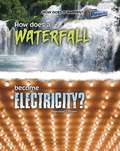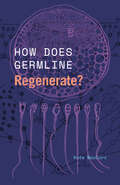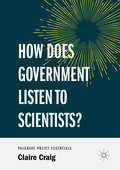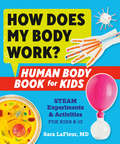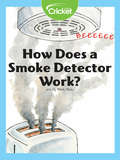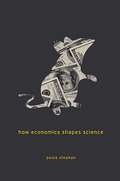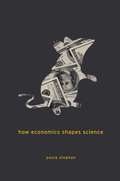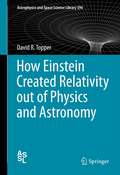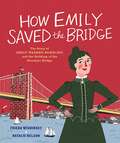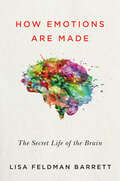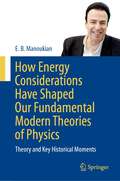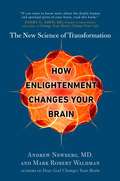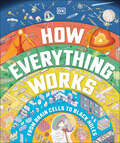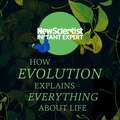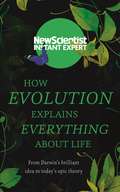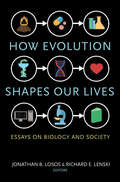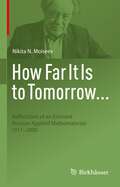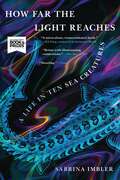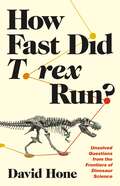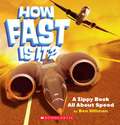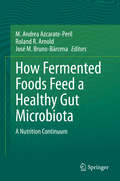- Table View
- List View
How Does A Waterfall Become Electricity? (How Does It Happen)
by Robert SneddenWhat is the world's tallest waterfall?What is the world's tallest waterfall? How do dams help generate water power? What happens when a waterwheel spins? This series explores the causes and effects that shape our world. From the underwater volcanoes that sprout into islands, to the rushing waterfalls that spark electric currents, this series demonstrates how both natural and man-made phenomena occur.
How Does Germline Regenerate? (Convening Science: Discovery at the Marine Biological Laboratory)
by Kate MacCordA concise primer that complicates a convenient truth in biology—the divide between germ and somatic cells—with far-reaching ethical and public policy ramifications. Scientists have long held that we have two kinds of cells—germ and soma. Make a change to germ cells—say using genome editing—and that change will appear in the cells of future generations. Somatic cells are “safe” after such tampering; modify your skin cells, and your future children’s skin cells will never know. And, while germ cells can give rise to new generations (including all of the somatic cells in a body), somatic cells can never become germ cells. How did scientists discover this relationship and distinction between somatic and germ cells—the so-called Weismann Barrier—and does it actually exist? Can somatic cells become germ cells in the way germ cells become somatic cells? That is, can germ cells regenerate from somatic cells even though conventional wisdom denies this possibility? Covering research from the late nineteenth century to the 2020s, historian and philosopher of science Kate MacCord explores how scientists came to understand and accept the dubious concept of the Weismann Barrier and what profound implications this convenient assumption has for research and policy, from genome editing to stem cell research, and much more.
How Does Government Listen to Scientists?
by Claire CraigThis Palgrave Policy Essential draws together recent developments in the field of science in government, policy and public debate. Practice and academic insights from a wide variety of fields have both moved on in the last decade and this book provides a consolidated survey of the relatively well established but highly scattered set of insights about the provision of deeply technical expertise in policy making (models of climate or disease, risk, Artificial Intelligence and ethics, and so on). It goes on to link this to emerging ideas about futures thinking, public engagement, narrative, and the role of values and sentiment alongside the place of scientific and scholarly insights in public decision-making and debate. The book offers an accessible overview aimed at practitioners; policy-makers looking to understand how to work with researchers, researchers looking to work with policy-makers, and the increasing numbers and types of “brokers” - people working at the interface, in science advice, public engagement and communication of science, and in expert support to decision-making in the public and private sectors. In addition to outlining recent insights and placing them in the established frameworks of authors such as Pielke and Jasanoff, the book also brings in relevant areas less traditionally associated with the subject but of increasing importance, such as modelling, futures and narrative.
How Does Motion Energy Change in a Collision?: Student Activity Guide
by The Smithsonian InstitutionNIMAC-sourced textbook
How Does My Body Work? Human Body Book for Kids: STEAM Experiments and Activities for Kids 8-12
by Sara LaFleurHow does your body work? This fun human anatomy book helps kids 8-12 answer that question through awesome, hands-on STEAM/STEM experiments and activities.Entertaining and interactive, The Human Body Book for Kids shows curious kids how their body systems help them move, breathe, fight infections, and keep them alive!Filled with fascinating information about human anatomy, this exciting science book features: • More than 40 STEAM experiments and activities that help kids learn about their amazing bodies. • Full-color illustrations and photographs that highlight the cells, tissues, organs and body systems as well as explain the steps and outcomes of the experiments. • A doctor author, an MD who works with both children and adults and is an expert on the human body inside and out. • Weird and wonderful facts about the human body: Did you know that you&’re about 1 cm taller in the morning than the evening? That a baby is born with 300 bones but has only 206 by the time they&’re an adult? That some children are born with an extra set of ribs surrounding the lungs called &“gorilla ribs&”? • Learning and fun together: Kids will create models, eat experiments, and show off their STEAM skills to family and friends. Endorsed by the co-founder of Apple&’s Siri, this educational book is a great resource for answering kids&’ questions about how their bodies work.
How Does Olive Oil Lose its Virginity?: Answers to the Enigmatic Questions of Contemporary Life
by Mark Watson Bruce TindallThis much anticipated sequel to the authors' popular Did Mohawks Wear Mohawks? stimulates the mind as much as it tickles the funny bone with scores of concise, witty answers to the questions you never dared to ask Mom or your high school science teacher! From the ridiculous to the sublime, Tindall and Watson tackle the conundrums of the day, examining everything from the history of "booing" bad performances to the mysterious darkness that lurks in the heart of the oyster. Whether the subject is soft drinks or shrunken heads, bumper stickers or boomerangs, How Does Olive Oil Lose Its Virginity? is your road map through an increasingly wacky world. With over 50 questions on a myriad of topics, How Does Olive Oil Lose Its Virginity? provides readers with hours of entertainment and a wealth of factual knowledge. Each answer has been carefully researched and well documented and offers great background information. And of course, all the answers are peppered with the trademark wit and spunk popularized by Tindall and Watson.
How Does a Smoke Detector Work?
by Liz HuyckEver wonder why a smoke alarm goes off? A battery, siren, and metal can work together to detect smoke and sound the alarm when catching a whiff of smoke.
How Economics Shapes Science
by Paula StephanAt a time when science is seen as an engine of economic growth, Paula Stephan brings a keen understanding of the cost-benefit calculations made by individuals and institutions as they compete for resources and reputation in scientific fields. She highlights especially the growing gap between the biomedical sciences and physics/engineering.
How Economics Shapes Science
by Paula StephanThe beauty of science may be pure and eternal, but the practice of science costs money. And scientists, being human, respond to incentives and costs, in money and glory. Choosing a research topic, deciding what papers to write and where to publish them, sticking with a familiar area or going into something new—the payoff may be tenure or a job at a highly ranked university or a prestigious award or a bump in salary. The risk may be not getting any of that. At a time when science is seen as an engine of economic growth, Paula Stephan brings a keen understanding of the ongoing cost-benefit calculations made by individuals and institutions as they compete for resources and reputation. She shows how universities offload risks by increasing the percentage of non-tenure-track faculty, requiring tenured faculty to pay salaries from outside grants, and staffing labs with foreign workers on temporary visas. With funding tight, investigators pursue safe projects rather than less fundable ones with uncertain but potentially path-breaking outcomes. Career prospects in science are increasingly dismal for the young because of ever-lengthening apprenticeships, scarcity of permanent academic positions, and the difficulty of getting funded. Vivid, thorough, and bold, How Economics Shapes Science highlights the growing gap between the haves and have-nots—especially the vast imbalance between the biomedical sciences and physics/engineering—and offers a persuasive vision of a more productive, more creative research system that would lead and benefit the world.
How Einstein Created Relativity out of Physics and Astronomy
by David TopperThis book tracks the history of the theory of relativity through Einstein's life, with in-depth studies of its background as built upon by ideas from earlier scientists. The focus points of Einstein's theory of relativity include its development throughout his life; the origins of his ideas and his indebtedness to the earlier works of Galileo, Newton, Faraday, Mach and others; the application of the theory to the birth of modern cosmology; and his quest for a unified field theory. Treading a fine line between the popular and technical (but not shying away from the occasional equation), this book explains the entire range of relativity and weaves an up-to-date biography of Einstein throughout. The result is an explanation of the world of relativity, based on an extensive journey into earlier physics and a simultaneous voyage into the mind of Einstein, written for the curious and intelligent reader.
How Emily Saved the Bridge: The Story of Emily Warren Roebling and the Building of the Brooklyn Bridge
by Frieda WishinskyThe amazing story of Emily Warren Roebling, the woman who stepped in to oversee the construction of the Brooklyn Bridge, which was completed in 1883.Emily was not an engineer, but she was educated in math and science. She married Washington Roebling, the chief engineer of the famous bridge. When Washington became ill from decompression sickness, Emily stepped in, doing everything from keeping the books, to carrying messages for her husband, to monitoring the construction of the bridge. She was the first person to cross the Brooklyn Bridge when it opened.Emily, who went on to study law among many other accomplishments, is an inspiration to all, as demonstrated through Frieda Wishinsky’s informative and engaging text and Natalie Nelson’s distinctive collage illustrations. Speech bubbles revealing imagined dialogue add a playful note to this historical account, which includes fascinating facts about the Brooklyn Bridge and a further reading list.Key Text Featuresfurther readingspeech bubblesCorrelates to the Common Core State Standards in English Language Arts:CCSS.ELA-LITERACY.RL.2.1Ask and answer such questions as who, what, where, when, why, and how to demonstrate understanding of key details in a text.CCSS.ELA-LITERACY.RL.4.3Describe in depth a character, setting, or event in a story or drama, drawing on specific details in the text (e.g., a character's thoughts, words, or actions).
How Emotions Are Made: The Secret Life of the Brain (Expert Thinking Ser.)
by Prof. Lisa Feldman BarrettA new theory of how the brain constructs emotions that could revolutionize psychology, health care, law enforcement, and our understanding of the human mind Emotions feel automatic, like uncontrollable reactions to things we think and experience. Scientists have long supported this assumption by claiming that emotions are hardwired in the body or the brain. Today, however, the science of emotion is in the midst of a revolution on par with the discovery of relativity in physics and natural selection in biology—ans this paradigm shift has far-reaching implications for us all. Leading the charge is psychologist and neuroscientist Lisa Feldman Barrett, whose theory of emotion is driving a deeper understanding of the mind and brain, and shedding new light on what it means to be human. Her research overturns the widely held belief that emotions are housed in different parts of the brain and are universally expressed and recognized. Instead, she has shown that emotion is constructed in the moment, by core systems that interact across the whole brain, aided by a lifetime of learning. This new theory means that you play a much greater role in your emotional life than you ever thought. Its repercussions are already shaking the foundations not only of psychology but also of medicine, the legal system, child-rearing, meditation, and even airport security. Why do emotions feel automatic? Does rational thought really control emotion? How does emotion affect disease? How can you make your children more emotionally intelligent? How Emotions Are Made answers these questions and many more, revealing the latest research and intriguing practical applications of the new science of emotion, mind, and brain.
How Energy Considerations Have Shaped Our Fundamental Modern Theories of Physics: Theory and Key Historical Moments
by E. B. ManoukianAt long last, with sufficient technical details, emphasizing key historical moments, a book that develops all of fundamental modern theoretical physics from energy considerations in a compact form. Starting with a few electron-volts of atoms in the quantum world at low energies extending up to quantum gravity and beyond to the birth of the Universe, readers will experience the entire spectrum of fundamental modern theoretical physics, with one theory leading to another in an integrated unified manner. Energy considerations lead to the development of special and general relativity, quantum field theory, renormalization theory, modern quantum electrodynamics, electro-weak theory, the standard model of particle physics, grand unified theories, string theory, the current standard model of inflationary big bang theory, and even to the birth of the Higgs field, and in developments of quantum gravity. Unfortunately, due to strong specialization within theirfields, students and many practicing physicists are exposed only to parts of the beautiful story of modern fundamental physics. Here the entire story is told! This is a must-read book for graduate students, advanced undergraduate students, instructors and professionals who are interested in all aspects of fundamental modern theoretical physics and key historical moments in its development.
How Enlightenment Changes Your Brain: The New Science of Transformation
by Andrew Newberg Mark Robert WaldmanThe bestselling authors of How God Changes Your Brain reveal the neurological underpinnings of enlightenment, offering unique strategies to help readers experience its many benefits. In this original and groundbreaking book, Andrew Newberg, M.D., and Mark Robert Waldman turn their attention to the pinnacle of the human experience: enlightenment. Through his brain- scan studies on Brazilian psychic mediums, Sufi mystics, Buddhist meditators, Franciscan nuns, Pentecostals, and participants in secular spirituality rituals, Newberg has discovered the specific neurological mechanisms associated with the enlightenment experience--and how we might activate those circuits in our own brains. In his survey of more than one thousand people who have experienced enlightenment, Newberg has also discovered that in the aftermath they have had profound, positive life changes. Enlightenment offers us the possibility to become permanently less stress-prone, to break bad habits, to improve our collaboration and creativity skills, and to lead happier, more satisfying lives. Relaying the story of his own transformational experience as well as including the stories of others who try to describe an event that is truly indescribable, Newberg brings us a new paradigm for deep and lasting change.From the Hardcover edition.
How Everything Works
by DKDiscover an all-in-one encyclopedia that takes you on an explanatory tour of the world from your own body to outer space.Have you ever wondered how an email gets to someone on the other side of the world in just a few seconds or why it&’s a bad idea to stand under a tree during a thunderstorm? Discover the answers to all these questions and more with these mind-boggling how things work books for children aged 9 and above!Each page of this mind-blowingly detailed and ambitious encyclopedia will guide you through the natural world and the technology that surrounds you. Giant, page-filling illustrations take objects apart – or take the roofs and walls off buildings – to show you how they work, explaining both basic principles (such as photosynthesis) as well as broader concepts (like how all the living things in a rainforest interact). Explore each and every page of this engaging how things work book to discover:- Key insights into both the natural and human worlds- Striking photography that brings certain concepts to life- A diverse range of chapters coinciding with STEM subjects at school In this how things work encyclopedia, chapters range from the human body to cities and industry, to planet Earth, taking in sleep patterns, cooking, sewage systems, wind farms, fungi spores, and plate tectonics along the way. How Everything Works is perfect for children studying STEM subjects at school or anyone who is simply curious about how nature and the modern world work.
How Evolution Explains Everything About Life: From Darwin's brilliant idea to today's epic theory (New Scientist Instant Expert)
by New ScientistHow did we get here? All cultures have a creation story, but a little over 150 years ago Charles Darwin introduced a revolutionary new one. We, and all living things, exist because of the action of evolution on the first simple life form and its descendants.We now know that it has taken 3.8 billions of years of work by the forces of evolution to turn what was once a lump of barren rock into the rich diversity of into plants, animals and microbes that surround us. In the process, evolution has created all manner of useful adaptions, from biological computers (brains) to a system to capture energy from the sun (photosynthesis). But how does evolution actually work? In Evolution, leading biologists and New Scientist take you on a journey of a lifetime, exploring the question of whether life is inevitable or a one-off fluke, and how it got kick-started. Does evolution have a purpose or direction? Are selfish genes really the driving force of evolution? And is evolution itself evolving?ABOUT THE SERIESNew Scientist Instant Expert books are definitive and accessible entry points to the most important subjects in science; subjects that challenge, attract debate, invite controversy and engage the most enquiring minds. Designed for curious readers who want to know how things work and why, the Instant Expert series explores the topics that really matter and their impact on individuals, society, and the planet, translating the scientific complexities around us into language that's open to everyone, and putting new ideas and discoveries into perspective and context.
How Evolution Explains Everything About Life: From Darwin's brilliant idea to today's epic theory (New Scientist Instant Expert)
by New ScientistThe journey of a lifetime exploring the question of whether life is inevitable or a one-off fluke, and how it got kick-started.How did we get here? All cultures have a creation story, but a little over 150 years ago Charles Darwin introduced a revolutionary new one. We, and all living things, exist because of the action of evolution on the first simple life form and its descendants.We now know that it has taken 3.8 billions of years of work by the forces of evolution to turn what was once a lump of barren rock into the rich diversity of into plants, animals and microbes that surround us. In the process, evolution has created all manner of useful adaptions, from biological computers (brains) to a system to capture energy from the sun (photosynthesis). But how does evolution actually work? In Evolution, leading biologists and New Scientist take you on a journey of a lifetime, exploring the question of whether life is inevitable or a one-off fluke, and how it got kick-started. Does evolution have a purpose or direction? Are selfish genes really the driving force of evolution? And is evolution itself evolving?ABOUT THE SERIESNew Scientist Instant Expert books are definitive and accessible entry points to the most important subjects in science; subjects that challenge, attract debate, invite controversy and engage the most enquiring minds. Designed for curious readers who want to know how things work and why, the Instant Expert series explores the topics that really matter and their impact on individuals, society, and the planet, translating the scientific complexities around us into language that's open to everyone, and putting new ideas and discoveries into perspective and context.(P) 2017 Hodder & Stoughton Limited
How Evolution Explains Everything About Life: From Darwins brilliant idea to todays epic theory (Instant Expert Ser.)
by New ScientistHow did we get here? All cultures have a creation story, but a little over 150 years ago Charles Darwin introduced a revolutionary new one. We, and all living things, exist because of the action of evolution on the first simple life form and its descendants.We now know that it has taken 3.8 billions of years of work by the forces of evolution to turn what was once a lump of barren rock into the rich diversity of into plants, animals and microbes that surround us. In the process, evolution has created all manner of useful adaptions, from biological computers (brains) to a system to capture energy from the sun (photosynthesis). But how does evolution actually work? In Evolution, leading biologists and New Scientist take you on a journey of a lifetime, exploring the question of whether life is inevitable or a one-off fluke, and how it got kick-started. Does evolution have a purpose or direction? Are selfish genes really the driving force of evolution? And is evolution itself evolving?ABOUT THE SERIESNew Scientist Instant Expert books are definitive and accessible entry points to the most important subjects in science; subjects that challenge, attract debate, invite controversy and engage the most enquiring minds. Designed for curious readers who want to know how things work and why, the Instant Expert series explores the topics that really matter and their impact on individuals, society, and the planet, translating the scientific complexities around us into language that's open to everyone, and putting new ideas and discoveries into perspective and context.
How Evolution Explains Everything About Life: From Darwins brilliant idea to todays epic theory (Instant Expert)
by New ScientistHow did we get here? All cultures have a creation story, but a little over 150 years ago Charles Darwin introduced a revolutionary new one. We, and all living things, exist because of the action of evolution on the first simple life form and its descendants. We now know that it has taken 3.8 billions of years of work by the forces of evolution to turn what was once a lump of barren rock into the rich diversity of into plants, animals and microbes that surround us. In the process, evolution has created all manner of useful adaptions, from biological computers (brains) to a system to capture energy from the sun (photosynthesis). But how does evolution actually work? In How Evolution Explains Everything, leading biologists and New Scientist take you on a journey of a lifetime, exploring the question of whether life is inevitable or a one-off fluke, and how it got kick-started. Does evolution have a purpose or direction? Are selfish genes really the driving force of evolution? And is evolution itself evolving?
How Evolution Shapes Our Lives: Essays on Biology and Society
by Jonathan B. Losos Richard E. LenskiIt is easy to think of evolution as something that happened long ago, or that occurs only in "nature," or that is so slow that its ongoing impact is virtually nonexistent when viewed from the perspective of a single human lifetime. But we now know that when natural selection is strong, evolutionary change can be very rapid. In this book, some of the world's leading scientists explore the implications of this reality for human life and society. With some twenty-three essays, this volume provides authoritative yet accessible explorations of why understanding evolution is crucial to human life--from dealing with climate change and ensuring our food supply, health, and economic survival to developing a richer and more accurate comprehension of society, culture, and even what it means to be human itself. Combining new essays with essays revised and updated from the acclaimed Princeton Guide to Evolution, this collection addresses the role of evolution in aging, cognition, cooperation, religion, the media, engineering, computer science, and many other areas. The result is a compelling and important book about how evolution matters to humans today.The contributors are Dan I. Andersson, Francisco J. Ayala, Amy Cavanaugh, Cameron R. Currie, Dieter Ebert, Andrew D. Ellington, Elizabeth Hannon, John Hawks, Paul Keim, Richard E. Lenski, Tim Lewens, Jonathan B. Losos, Virpi Lummaa, Jacob A. Moorad, Craig Moritz, Martha M. Muñoz, Mark Pagel, Talima Pearson, Robert T. Pennock, Daniel E. L. Promislow, Erik M. Quandt, David C. Queller, Robert C. Richardson, Eugenie C. Scott, H. Bradley Shaffer, Joan E. Strassmann, Alan R. Templeton, Paul E. Turner, and Carl Zimmer.
How Far It Is to Tomorrow...: Reflections of an Eminent Russian Applied Mathematician 1917-2000
by Nikita N. MoiseevThis is a translated autobiography of applied mathematician N. N. Moiseev, providing an insider’s view of the history of the Soviet Union from its founding in 1917 to its collapse in 1991, as well as a little of the aftermath.We see vividly the precariousness of life just after the October Revolution; his happy family life during the years 1921-28 of Lenin’s New Economic Policy; the subsequent destruction of his family by Stalin’s regime; his trials as a social outcast; his student days at Moscow State University; his experiences as a Soviet Air Force Engineer in World War II, including sorties as a gunner and a brush with an NKVD agent; post-war euphoria, marriage, and another round of ostracism; and then the vicissitudes of a highly varied academic career. Here we meet many famous Soviet and Western engineers and scientists. The last several chapters are devoted more to wide-ranging reflections on God, philosophy, science, communism, modelling the biosphere, and the threat of nuclear winter. His thoughts concerning the impending and then final collapse of the USSR, as well as hopes for Russia’s future, conclude the journey through Moiseev's life.
How Far the Light Reaches: A Life in Ten Sea Creatures
by Sabrina ImblerA fascinating tour of creatures from the surface to the deepest ocean floor: this "miraculous, transcendental book" invites us to envision wilder, grander, and more abundant possibilities for the way we live (Ed Yong, author of An Immense World). A queer, mixed race writer working in a largely white, male field, science and conservation journalist Sabrina Imbler has always been drawn to the mystery of life in the sea, and particularly to creatures living in hostile or remote environments. Each essay in their debut collection profiles one such creature, including: ·the mother octopus who starves herself while watching over her eggs, ·the Chinese sturgeon whose migration route has been decimated by pollution and dams, ·the bizarre, predatory Bobbitt worm (named after Lorena), ·the common goldfish that flourishes in the wild, ·and more. Imbler discovers that some of the most radical models of family, community, and care can be found in the sea, from gelatinous chains that are both individual organisms and colonies of clones to deep-sea crabs that have no need for the sun, nourished instead by the chemicals and heat throbbing from the core of the Earth. Exploring themes of adaptation, survival, sexuality, and care, and weaving the wonders of marine biology with stories of their own family, relationships, and coming of age, How Far the Light Reaches is a shimmering, otherworldly debut that attunes us to new visions of our world and its miracles. WINNER OF THE LOS ANGELES TIMES BOOK PRIZE in SCIENCE & TECHNOLOGY Finalist for the Lambda Literary Award One of TIME&’s 10 Best Nonfiction Books of the Year • A PEOPLE Best New Book • A Barnes & Noble and SHELF AWARENESS Best Book of 2022 • An Indie Next Pick • One of Winter&’s Most Eagerly Anticipated Books: VANITY FAIR, VULTURE, BOOKRIOT
How Fast Did T. rex Run?: Unsolved Questions from the Frontiers of Dinosaur Science
by David HoneThe revolution in science that is transforming our understanding of dinosaursIn just the past twenty years, we have learned more about dinosaurs than we did in the previous two centuries. This book describes the extraordinary advances in palaeontology that are beginning to solve many of the mysteries surrounding these marvelous prehistoric creatures, from their ways of communicating to their mating habits, the color of their skin, their migration patterns and extinction. How did dinosaurs rear their young? What did they eat? What did T. rex actually do with those tiny arms? David Hone draws on his own discoveries at the forefront of dinosaur science to illuminate these and other questions.Each chapter in this lively and informative book covers a key topic in dinosaur science, such as origins, diversity, evolution, habitats, anatomy, behaviour, ecology and dinosaur descendants—the birds. For each topic, Hone discusses the history of what palaeontologists thought in the past, the new insights we are gleaning from recent fossil finds and the latest technologies and the gaps in our knowledge that still remain. He shares his own predictions about the research areas that may produce the next big ideas in dinosaur science and addresses the unknowns we may never solve.How Fast Did T. rex Run? reveals everything we now know about dinosaurs—and everything we don’t—and charts thrilling new directions for tomorrow’s generation of dinosaur scientists.
How Fast Is It?: A Zippy Book All About Speed
by Ben HillmanIn this third book by Ben Hillman, young readers will learn and see just how fast something is. By comparing objects such as the Thrust SSC (that's a Thrust-powered Super Sonic Car), an ostrich (don't underestimate the ostrich, my friend!), the human brain, and bamboo,wildly different objects are taken out of normal context and placed next to one another to allow for new and exciting perspectives. So just how fast is an ostrich? An ostrich would beat a top-notch professional cyclist in a ten-mile (sixteen km) race, hands down! While the best cyclists can race at blistering speeds of twenty-five miles per hour, the ostrich can run at forty-five miles per hour! Other books in the series that kids will enjoy: How Big Is It? and How Strong Is It?
How Fermented Foods Feed a Healthy Gut Microbiota: A Nutrition Continuum
by M. Andrea Azcarate-Peril Roland R. Arnold José M. Bruno-BárcenaThis book examines the role of fermented foods on human gut health and offers a unique contribution to this rapidly growing area of study. Fermented foods have been consumed by humans for millennia. This method of food preservation provided early humans with beneficial bacteria that re-populated the gut microbiota upon consumption. However, novel methods of production and conservation of food have led to severed ties between the food that modern humans consume and the gut microbiota. As a consequence, there has been a documented increase in the prevalence of autoimmune diseases and obesity, which has been correlated to decreased diversity of gut microbes, while infectious disorders have decreased in the three past decades.With the intention of providing a thorough overview of the relationship between fermented foods, nutrition, and health, the editors have grouped the chapters into three thematic sections: food and their associated microbes, the oral microbiome, and the gut microbiome. After an introduction dedicated to the environmental microbiome, Part I provides an overview of what is currently known about the microbes associated with different foods, and compares traditional forms of food preparation with current industrial techniques in terms of the potential loss of microbial diversity. The chapters in Part 2 explore the oral microbiota as a microbial gatekeeper and main contributor to the gut microbiota. Part 3 introduces beneficial modulators of the gut microbiome starting with the establishment of a healthy gut microbiota during infancy, and continuing with the role of probiotics and prebiotics in health preservation and the imbalances of the gut microbiota. In the final section the editors offer concluding remarks and provide a view of the future brought by the microbiome research revolution.This study is unique in its emphasis on the convergence of two very relevant fields of research: the field of studies on Lactic Acid Bacteria (LAB) and fermented foods, and microbiome research. The relationship between these fields, as presented by the research in this volume, demonstrates the intimate connection between fermented foods, the oral and gut microbiota, and human health. Although research has been done on the impact of diet on the gut microbiome there are no publications addressing the restorative role of food as microbe provider to the gut microbiota. This novel approach makes the edited volume a key resource for scientific researchers working in this field.
